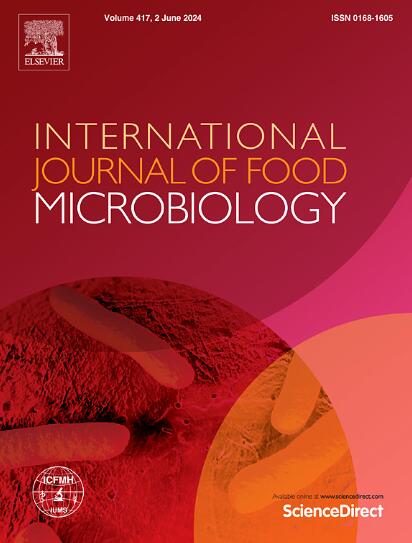Comparative analysis of the effects of Origanum vulgare essential oil and carvacrol nanoemulsified and non-nanoemulsified forms against Salmonella Typhimurium strains
IF 5.2
1区 农林科学
Q1 FOOD SCIENCE & TECHNOLOGY
International journal of food microbiology
Pub Date : 2025-05-19
DOI:10.1016/j.ijfoodmicro.2025.111273
引用次数: 0
Abstract
This study investigates the potential of Origanum vulgare L. (OVEO), carvacrol (CAR), and their nanoemulsions (nOVEO and nCAR) in subinhibitory concentrations as antimicrobial agents against S. typhimurium strains in vitro and in situ. The minimum inhibitory concentrations (MIC) ranged from 0.59 to 0.60 mg/mL for the nanoemulsions and 0.68 to 1.5 mg/mL for their non-nanoemulsified counterparts. Growth kinetics analysis showed that all treatments at 1/4 MIC, 1/2 MIC, and MIC reduced the growth rate and prolonged the lag phase. Flow cytometry analysis revealed that these treatments caused permeabilization of the cell membranes, with OVEO standing out for its highest effect on membrane rupture, even at subinhibitory concentrations. Regarding adhesion prevention, the nanoemulsions demonstrated equal or greater efficacy compared to non-nanoemulsified compounds, with >44.12 % inhibition even at the lowest tested concentration. In chicken fillets inoculated with a four-strain S. typhimurium cocktail, a reduction in bacterial counts was observed throughout the experiment. The highest reduction (0.82 ± 0.08 log CFU/g) was recorded on the eighth day of treatment with nOVEO at 2xMIC (2.86 mg/mL). Therefore, this study investigates the complexity of OVEO and CAR, highlighting their antimicrobial potential at different action targets against Salmonella, including biofilm adhesion inhibition and their application in contaminated food matrices. Additionally, it reveals that the reduction in droplet size in nanoemulsions can enhance the antimicrobial action of the essential oils, increasing their applicability and contributing significantly to food safety.
牛头草精油与香芹酚纳米乳化与非纳米乳化对鼠伤寒沙门菌作用的比较分析
本研究在体外和原位研究了土豆泥(Origanum vulgare L., OVEO)、香芹酚(carvacrol, CAR)及其亚抑制浓度纳米乳(nOVEO和nCAR)作为鼠伤寒沙门氏菌(S. typhimurium)菌株的抑菌潜力。纳米乳剂的最低抑菌浓度(MIC)为0.59 ~ 0.60 mg/mL,非纳米乳剂的最低抑菌浓度为0.68 ~ 1.5 mg/mL。生长动力学分析表明,1/4 MIC、1/2 MIC和MIC处理均降低了生长速度,延长了滞后期。流式细胞术分析显示,这些处理引起细胞膜通透性,OVEO对膜破裂的影响最大,即使在亚抑制浓度下也是如此。在防止黏附方面,纳米乳剂与非纳米乳剂表现出相同或更高的效果,即使在最低测试浓度下也有44.12%的抑制作用。在接种了四株鼠伤寒沙门氏菌鸡尾酒的鸡柳中,在整个实验中观察到细菌计数的减少。nOVEO在2xMIC (2.86 mg/mL)治疗第8天,减少量最高(0.82±0.08 log CFU/g)。因此,本研究探讨了OVEO和CAR的复杂性,强调了它们在不同作用靶点上对沙门氏菌的抑菌潜力,包括生物膜粘附抑制及其在受污染食品基质中的应用。此外,减小纳米乳中精油滴的大小可以增强精油的抗菌作用,增加精油的适用性,对食品安全有重要贡献。
本文章由计算机程序翻译,如有差异,请以英文原文为准。
求助全文
约1分钟内获得全文
求助全文
来源期刊
CiteScore
10.40
自引率
5.60%
发文量
322
审稿时长
65 days
期刊介绍:
The International Journal of Food Microbiology publishes papers dealing with all aspects of food microbiology. Articles must present information that is novel, has high impact and interest, and is of high scientific quality. They should provide scientific or technological advancement in the specific field of interest of the journal and enhance its strong international reputation. Preliminary or confirmatory results as well as contributions not strictly related to food microbiology will not be considered for publication.

 求助内容:
求助内容: 应助结果提醒方式:
应助结果提醒方式:


